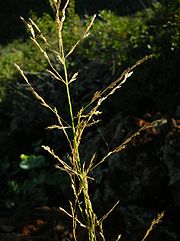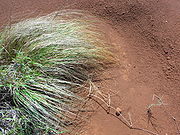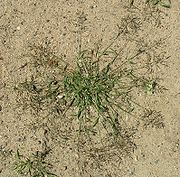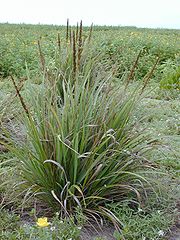
Lovegrass
Encyclopedia




Genus
In biology, a genus is a low-level taxonomic rank used in the biological classification of living and fossil organisms, which is an example of definition by genus and differentia...
of the Poaceae
Poaceae
The Poaceae is a large and nearly ubiquitous family of flowering plants. Members of this family are commonly called grasses, although the term "grass" is also applied to plants that are not in the Poaceae lineage, including the rushes and sedges...
(grass family
Family (biology)
In biological classification, family is* a taxonomic rank. Other well-known ranks are life, domain, kingdom, phylum, class, order, genus, and species, with family fitting between order and genus. As for the other well-known ranks, there is the option of an immediately lower rank, indicated by the...
) and the namesake of the tribe
Tribe (biology)
In biology, a tribe is a taxonomic rank between family and genus. It is sometimes subdivided into subtribes.Some examples include the tribes: Canini, Acalypheae, Hominini, Bombini, and Antidesmeae.-See also:* Biological classification* Rank...
Eragrostideae. It would remain therein as long as this group remains valid after revision of the Chloridoideae
Chloridoideae
Chloridoideae is a subfamily of the true grass family . The systematics of the main group of genera is in need of revision; they are traditionally divided into several tribes like the Eragrostideae....
, even if other genera presently placed in the Eragrostideae are moved elsewhere. The name of the genus is derived from the Greek
Greek language
Greek is an independent branch of the Indo-European family of languages. Native to the southern Balkans, it has the longest documented history of any Indo-European language, spanning 34 centuries of written records. Its writing system has been the Greek alphabet for the majority of its history;...
words ερως (eros), meaning "love," and αγρωστις (agrostis), meaning "grass."
Some are dispersed
Seed dispersal
Seed dispersal is the movement or transport of seeds away from the parent plant. Plants have limited mobility and consequently rely upon a variety of dispersal vectors to transport their propagules, including both abiotic and biotic vectors. Seeds can be dispersed away from the parent plant...
by passing animals; the grains' hooks latch on to fur or hair, or to clothes. Others are wind or gravity dispersed. Several herbivore
Herbivore
Herbivores are organisms that are anatomically and physiologically adapted to eat plant-based foods. Herbivory is a form of consumption in which an organism principally eats autotrophs such as plants, algae and photosynthesizing bacteria. More generally, organisms that feed on autotrophs in...
s feed on lovegrass, be it invertebrate
Invertebrate
An invertebrate is an animal without a backbone. The group includes 97% of all animal species – all animals except those in the chordate subphylum Vertebrata .Invertebrates form a paraphyletic group...
s – e.g. Lepidoptera
Lepidoptera
Lepidoptera is a large order of insects that includes moths and butterflies . It is one of the most widespread and widely recognizable insect orders in the world, encompassing moths and the three superfamilies of butterflies, skipper butterflies, and moth-butterflies...
caterpillar
Caterpillar
Caterpillars are the larval form of members of the order Lepidoptera . They are mostly herbivorous in food habit, although some species are insectivorous. Caterpillars are voracious feeders and many of them are considered to be pests in agriculture...
s such as those of the Zabulon Skipper
Zabulon Skipper
The Zabulon Skipper, Poanes zabulon, is a North American butterfly first described by the French naturalists Jean Baptiste Boisduval and John Eatton Le Conte from the state of Georgia, United States....
(Poanes zabulon) – or vertebrate
Vertebrate
Vertebrates are animals that are members of the subphylum Vertebrata . Vertebrates are the largest group of chordates, with currently about 58,000 species described. Vertebrates include the jawless fishes, bony fishes, sharks and rays, amphibians, reptiles, mammals, and birds...
s, such as the extinct Bluebuck
Bluebuck
The Bluebuck or Blue Antelope , sometimes called Blaubok, is an extinct species of antelope, the first large African mammal to disappear in historic times. It is related to the Roan Antelope and Sable Antelope, but slightly smaller than either...
(Hippotragus leucophaeus). The dense bunches of these grasses also provide cover for small animals such as the rare Botteri's Sparrow
Botteri's Sparrow
The Botteri's Sparrow, Aimophila botterii, is a medium-sized sparrow.This passerine bird is primarily found in Mexico, with a breeding range that extends into the southeastern tip of the U.S...
(Aimophila botterii); lovegrasses may be ground cover of key importance on ocean
Ocean
An ocean is a major body of saline water, and a principal component of the hydrosphere. Approximately 71% of the Earth's surface is covered by ocean, a continuous body of water that is customarily divided into several principal oceans and smaller seas.More than half of this area is over 3,000...
ic island
Island
An island or isle is any piece of sub-continental land that is surrounded by water. Very small islands such as emergent land features on atolls can be called islets, cays or keys. An island in a river or lake may be called an eyot , or holm...
s like Laysan
Laysan
Laysan , located northwest of Honolulu at N25° 42' 14" W171° 44' 04", is one of the Northwestern Hawaiian Islands. It comprises one land mass of , about 1 by 1.5 miles in size . It is an atoll of sorts, although the land completely surrounds a shallow central lake some above sea level that has...
, where other plants are rare.
They can be used as livestock
Livestock
Livestock refers to one or more domesticated animals raised in an agricultural setting to produce commodities such as food, fiber and labor. The term "livestock" as used in this article does not include poultry or farmed fish; however the inclusion of these, especially poultry, within the meaning...
fodder
Fodder
Fodder or animal feed is any agricultural foodstuff used specifically to feed domesticated livestock such as cattle, goats, sheep, horses, chickens and pigs. Most animal feed is from plants but some is of animal origin...
, the seeds appear to be of extremely high nutritional value at least in some species
Species
In biology, a species is one of the basic units of biological classification and a taxonomic rank. A species is often defined as a group of organisms capable of interbreeding and producing fertile offspring. While in many cases this definition is adequate, more precise or differing measures are...
, but they are also extremely tiny and collecting them for food is cumbersome and not usually done. A notable exception is Teff
Teff
Eragrostis tef, known as teff, taf , or khak shir , is an annual grass, a species of lovegrass native to the northern Ethiopian Highlands of Northeast Africa....
(E. tef), used to make most of the traditional breads of the Horn of Africa
Horn of Africa
The Horn of Africa is a peninsula in East Africa that juts hundreds of kilometers into the Arabian Sea and lies along the southern side of the Gulf of Aden. It is the easternmost projection of the African continent...
: Ethiopia
Ethiopia
Ethiopia , officially known as the Federal Democratic Republic of Ethiopia, is a country located in the Horn of Africa. It is the second-most populous nation in Africa, with over 82 million inhabitants, and the tenth-largest by area, occupying 1,100,000 km2...
n injera
Injera
Injera is a yeast-risen flatbread with a unique, slightly spongy texture. Traditionally made out of teff flour, it is a national dish in Ethiopia and Eritrea...
and Somalia
Somalia
Somalia , officially the Somali Republic and formerly known as the Somali Democratic Republic under Socialist rule, is a country located in the Horn of Africa. Since the outbreak of the Somali Civil War in 1991 there has been no central government control over most of the country's territory...
n laxoox
Laxoox
Lahoh, also spelled laxoox in Somali, is a spongy, pancake-like bread originating in Djibouti, Somalia and Yemen. It is also popular in Israel, where it was introduced by Yemenite Jews who immigrated there. In Yemen, it is often sold on the street by peddlers.-Preparation:Lahoh is prepared from a...
, and grown as a crop of commercial importance. E. clelandii and E. tremula are recorded as famine food
Famine food
A famine food or poverty food is any inexpensive or readily-available foodstuff used to nourish people in times of extreme poverty or starvation, as during a war or famine...
s in Australia
Australia
Australia , officially the Commonwealth of Australia, is a country in the Southern Hemisphere comprising the mainland of the Australian continent, the island of Tasmania, and numerous smaller islands in the Indian and Pacific Oceans. It is the world's sixth-largest country by total area...
and Chad
Chad
Chad , officially known as the Republic of Chad, is a landlocked country in Central Africa. It is bordered by Libya to the north, Sudan to the east, the Central African Republic to the south, Cameroon and Nigeria to the southwest, and Niger to the west...
, respectively.
Other species, e.g. E. amabilis, are used as ornamental plant
Ornamental plant
Ornamental plants are plants that are grown for decorative purposes in gardens and landscape design projects, as house plants, for cut flowers and specimen display...
s. E. cynosuroides is used in the pūjā rites in the Hindu temple at Karighatta. Bahia Lovegrass (E. bahiensis) is known as a hyperaccumulator of Caesium-137
Caesium-137
Caesium-137 is a radioactive isotope of caesium which is formed as a fission product by nuclear fission.It has a half-life of about 30.17 years, and decays by beta emission to a metastable nuclear isomer of barium-137: barium-137m . Caesium-137 is a radioactive isotope of caesium which is formed...
and can be grown to remove these highly toxic and radioactive atoms from the environment. Weeping lovegrass (E. curvula) has been planted extensively to combat soil erosion.
Formerly placed here
- Briza uniolae (Nees) Steud. (as E. uniolae Nees)
- Coelachyrum piercei (Benth.) Bor (as E. piercei Benth.)
- Coelachyrum yemenicum (Schweinf.) S.M.Phillips (as E. yemenica Schweinf.)
- Desmostachya bipinnataDesmostachya bipinnataDesmostachya bipinnata, commonly known in English by the names Halfa grass, Big cordgrass, and Salt reed-grass, is an Old World perennial grass, long known and used in human history...
(L.) Stapf (as E. cynosuriodes (Retz.) P.Beauv.) - Eragrostiella brachyphylla (Stapf) Bor (as E. brachyphylla Stapf)
- Harpachne schimperi Hochst. ex A.Rich. (as E. schimperi (Hochst. ex A. Rich.) Benth.)
- Leptochloa decipiens subsp. asthenes (Roem. & Schult.) N.Snow (as E. ciliolata Jedwabn.)
- Poa fendleriana subsp. fendleriana (as E. fendleriana Steud.)

